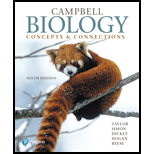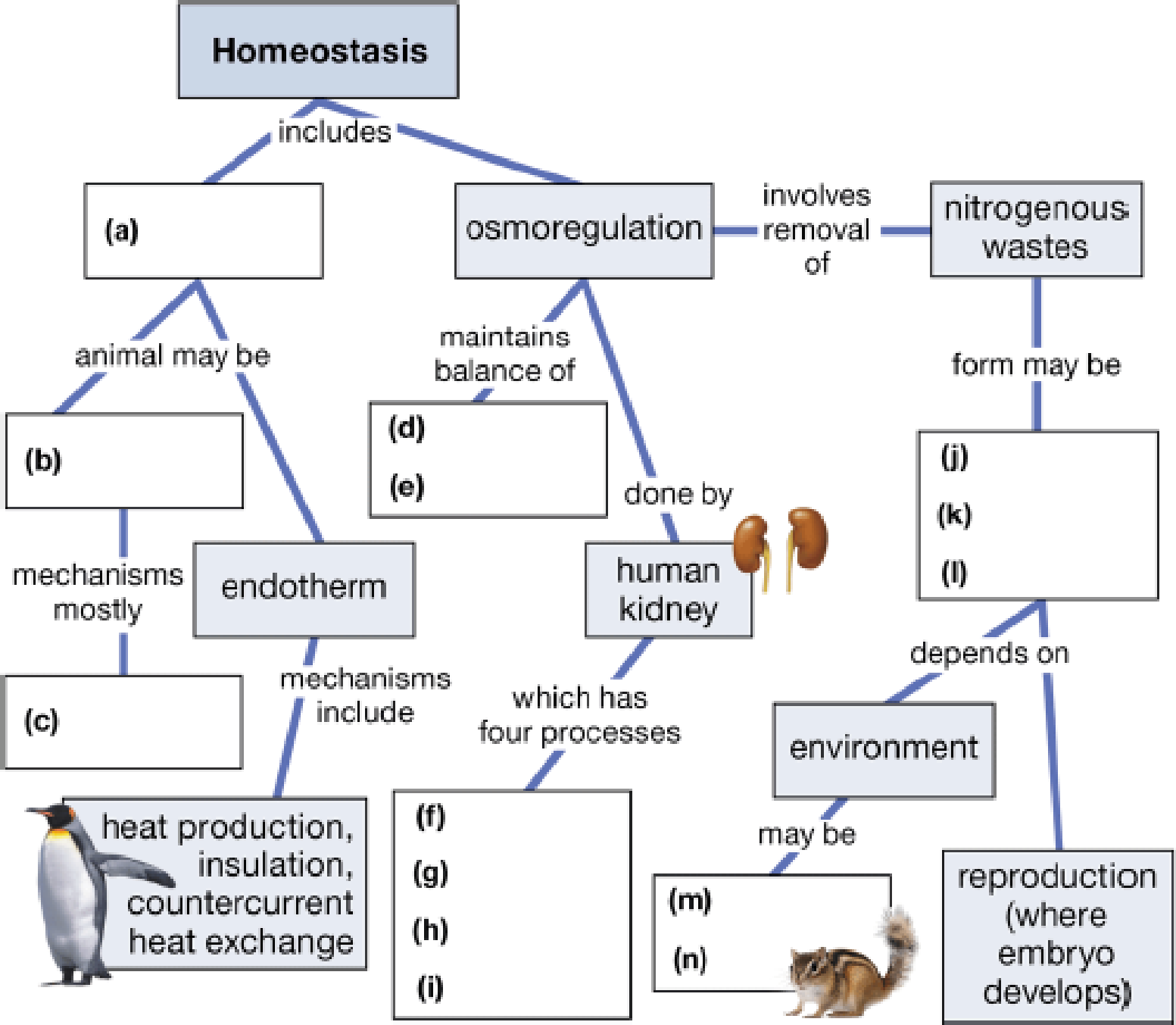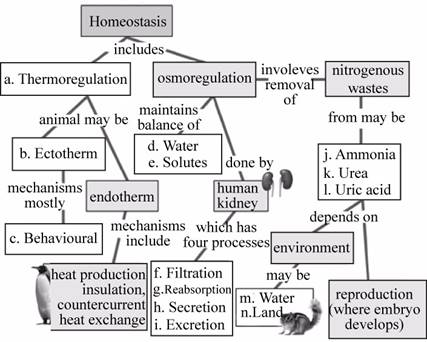
Concept explainers
Complete this map, which presents the three main topics of this chapter.

To complete: The given map representing the three main topics of this chapter.
Concept introduction: The processes such as thermoregulation and Osmoregulation are very essential for maintaining the homeostasis of the body.
The change in constant internal body temperature can impair the activity of enzymes and therefore, can result in death. The disturbance in osmolarity can have similar effects.
Answer to Problem 1CC
Pictorial representation: Fig.1 shows the completed map representing the three main topics of this chapter.

Fig.1: Three main topics of the chapter.
Explanation of Solution
(a)
Correct answer: Thermoregulation
Explanation: Thermoregulation is a homeostatic mechanism in animals that maintains the constant internal body temperature regardless of external temperature fluctuations. Hence the correct answer is thermoregulation.
(b)
Correct answer: Ectotherm
Explanation: Ectotherms are those animals that can regulate their body temperatures by gaining heat from surroundings. Hence, the correct answer is ectotherm.
(c)
Correct answer: Behavioral
Explanation: Ectotherm maintains constant body temperatures by behavioral responses such as huddling, migration and sun bathing. Hence, the correct answer is behavioral response.
(d)
Correct answer: Water
Explanation: The Osmoregulation is a process by which an organism maintains balance of water in the body. Hence, the correct answer is water.
(e)
Correct answer: Solutes
Explanation: The Osmoregulation is a process by which an organism maintains balance of solutes in the body. Hence, the correct answer is solutes.
(f)
Correct answer: Filtration
Explanation: It is one of the four processes by which the kidneys produce urine. In this process, the hydrostatic pressure in the glomerular capillaries drives the filtration of blood. Hence, the correct answer is filtration.
(g)
Correct answer: Reabsorption
Explanation: It is one of the four processes by which the kidneys produce urine. In this process, the essential nutrients such as glucose, amino acids, salts and water are reabsorbed into the blood. Hence the correct answer is reabsorption.
(h)
Correct answer: Secretion
Explanation: It is one of the four processes by which the kidneys produce urine. In this process, the extra ions, drugs and other harmful substances are secreted into the renal tubules and are excreted out of the body. This process takes place in the distal convoluted tubules. Hence, the correct answer is secretion.
(i)
Correct answer: Excretion
Explanation: It is the last process in the urine production. In this process, the harmful waste substances are eliminated from the kidneys in the form of urine. Hence, the correct answer is excretion.
(j)
Correct answer: Ammonia
Explanation: Ammonia is one of the form in which nitrogenous waste can be eliminated. The excretion of nitrogenous waste in the form of ammonia generally occurs in aquatic organisms. Hence the correct answer is ammonia.
(k)
Correct answer: Urea
Explanation: Urea is one of the form in which nitrogenous waste can be eliminated. Many mammals including humans, amphibians and some bony fishes excrete urea. Hence the correct answer is urea.
(l)
Correct answer: Uric acid
Explanation: Uric acid is one of the form in which nitrogenous waste can be eliminated. Many birds, some reptile and some insect excrete uric acid. Hence the correct answer is uric acid.
(m)
Correct answer: Water
Explanation: The form in which the nitrogenous waste is to be excreted depends on the environment, which can be water. Hence the correct answer is water.
(n)
Correct answer: Land
Explanation: The form in which the nitrogenous waste is to be excreted depends on the environment, which can be land. Hence the correct answer is land.
Want to see more full solutions like this?
Chapter 25 Solutions
Campbell Biology: Concepts & Connections (9th Edition)
- Describe the levels of structural hierarchy for the human body, starting with the organismal level and ending with the chemical level. In addition, you should make sure you link each level to the previous level, emphasizing the structural relationships.arrow_forward9 S es Read the section "Investigating Life: In (Extremely) Cold Blood." Then, drag and drop the terms on the left to complete the concept map. Red blood cells Genes Icefishes -have mutated have colorless Oxygen have few lack encode Blood Cellular respiration consists of- contain carries is a Platelets White blood cells carries low amounts of Hemoglobin is necessary for Plasma Protein Reset.arrow_forwardPlating 50 microliters of a sample diluted by a factor of 10-6 produced 91 colonies. What was the originalcell density (CFU/ml) in the sample?arrow_forward
- Every tutor here has got this wrong, don't copy off them.arrow_forwardSuppose that the population from question #1 (data is in table below) is experiencing inbreeding depression (F=.25) (and no longer experiencing natural selection). Calculate the new expected genotype frequencies (f) in this population after one round of inbreeding. Please round to 3 decimal places. Genotype Adh Adh Number of Flies 595 Adh Adh 310 Adhs Adhs 95 Total 1000 fladh Adh- flAdn Adh fAdhs Adharrow_forwardWhich of the following best describes why it is difficult to develop antiviral drugs? Explain why. A. antiviral drugs are very difficult to develop andhave no side effects B. viruses are difficult to target because they usethe host cell’s enzymes and ribosomes tometabolize and replicate C. viruses are too small to be targeted by drugs D. viral infections usually clear up on their ownwith no problemsarrow_forward
- This question has 3 parts (A, B, & C), and is under the subject of Nutrition. Thank you!arrow_forwardThey got this question wrong the 2 previous times I uploaded it here, please make sure it's correvct this time.arrow_forwardThis question has multiple parts (A, B & C), and under the subject of Nutrition. Thank you!arrow_forward
- Calculate the CFU/ml of a urine sample if 138 E. coli colonies were counted on a Nutrient Agar Plate when0.5 mls were plated on the NA plate from a 10-9 dilution tube. You must highlight and express your answerin scientific notatioarrow_forwardDon't copy off the other answer if there is anyarrow_forwardAnswerarrow_forward
- Health Safety And Nutrition F/Young ChildHealth & NutritionISBN:9781305144767Author:MAROTZPublisher:CengageCase Studies In Health Information ManagementBiologyISBN:9781337676908Author:SCHNERINGPublisher:Cengage
- Essentials Health Info Management Principles/Prac...Health & NutritionISBN:9780357191651Author:BowiePublisher:Cengage





